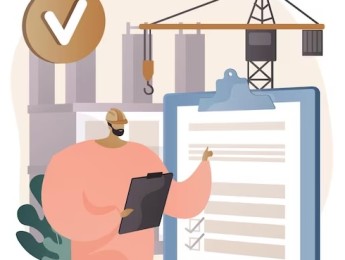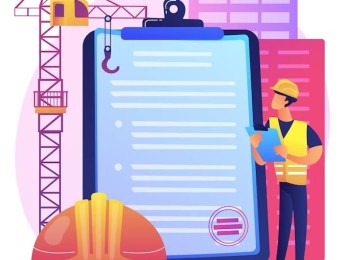Envelope inspections within the construction and building industry are vital to the success of individual projects. They ensure the highest level of workmanship, the quality of materials, and the safety of the finished building.
Gaining extensive comprehension of the processes of various construction and building inspections can lead to an increase in knowledge that can be applied throughout the project. These processes must be carried out utilising particular tests and methods to prevent the possibility of damaging materials post-project completion. Understanding the inspection guidelines and potential faults of the material can result in greater awareness when completing the task initially.
To ensure effective inspections, assessing the reason they are conducted is crucial. Inspections will compare various aspects of the established guidelines to measure the quality of materials and the workers' skills. These inspections will highlight shortcomings within the project and allow those responsible to revisit and make the necessary adjustments. Not only do inspections ensure quality, but they also ensure health and safety. If an aspect of the building is unreliable, it potentially could lead to greater structural issues or cause great harm to those working or the public.
Upon completion of this course, participants will be able to:
- Understand the importance of envelope inspections.
- Identify the role envelope inspections play within a quality management system.
- Manage and monitor workmanship within building construction.
- Review non-destructive examination methods for steel and welding.
- Effectively inspect completed tasks to ensure safety and eliminate any potential risks.
- Assess how envelope inspection is applied to a range of areas within a construction site.
- Evaluate the concepts, principles and processes of an envelope inspection.
- Utilise effective envelope infections to reduce project costs and waste.
This course is designed for anyone responsible for construction inspections or those who wish to develop existing skills further. It would be most beneficial for:
- Architects
- Building and Construction Inspectors
- Project Managers
- Operations Managers
- Project Engineers
- NDE Lab Personnel
- Contractors and Subcontractors
- Engineering Personnel
This course uses a variety of adult learning styles to aid full understanding and comprehension. Participants will review examples of completed building inspections to highlight areas of importance throughout the process.
They will have , and group activities, participants will have the opportunity to develop their knowledge and practical skills related to the content taught the necessary equipment to participate in the learning exercises. With presentations, practical demonstrations, discussions and group activities, participants will have full opportunity to develop their knowledge and practical skills related to the taught content.
Day 5 of each course is reserved for a Q&A session, which may occur off-site. For 10-day courses, this also applies to day 10
Section 1: Quality Management
- Defining quality management for a construction project.
- Explaining the benefits of effective quality management.
- Describing what an inspection is and its necessity.
- Analysing what components would require special inspections.
- The roles and responsibilities of Special Inspectors.
- Maintaining records detailing the process of special inspections, their findings and what adjustments are to be made.
Section 2: General Inspection Guidelines
- The role and responsibilities of a field inspector.
- The vitality of strict guidelines when conducting inspections.
- Reviewing what procedures are listed under general inspection guidelines.
- Analysing the general inspection guidelines for various components.
- Understanding the risks and potential faults that may occur with a lack of effective inspections.
- Defining NDT and NDE.
Section 3: Steel Structure Inspection Guidelines
- The principles of steel structure inspections.
- Assessing the inspection guidelines for steel structures.
- What structures need to be inspected – anchor bolts, dowels and hold-down systems.
- The NDT methods of testing steel structures.
- Conducting level 2 and level 3 NDE.
- What key factors are to be tested.
Section 4: Soil Inspection Guidelines
- Understanding why soil inspections are necessary.
- What factors influence an effective soil inspection.
- Earthwork, asphaltic concrete and road construction inspection guidelines and principles.
- What elements of soil need to be tested.
- Describing the ideal outcome for the project, and what adjustments need to be made if soil is not up to standard.
Section 5: Architectural Work Inspection Guidelines
- Identifying what the building envelope involves.
- Measuring the compatibility of building envelope components with one another.
- What features must be inspected – insulation, doors, windows, plastering and more.
- Understanding what safety regulations apply to each element.
- Creating effective records detailing conducted inspections and their results.
Upon successful completion of this training course, delegates will be awarded a Holistique Training Certificate of Completion. For those who attend and complete the online training course, a Holistique Training e-Certificate will be provided.
Holistique Training Certificates are accredited by the British Assessment Council (BAC) and The CPD Certification Service (CPD), and are certified under ISO 9001, ISO 21001, and ISO 29993 standards.
CPD credits for this course are granted by our Certificates and will be reflected on the Holistique Training Certificate of Completion. In accordance with the standards of The CPD Certification Service, one CPD credit is awarded per hour of course attendance. A maximum of 50 CPD credits can be claimed for any single course we currently offer.
- Course Code IND13-102
- Course Format Online, Classroom,
- Duration 5 days














